Desa CGG3630P, CGG3324PT, CGG2618P User Manual 2
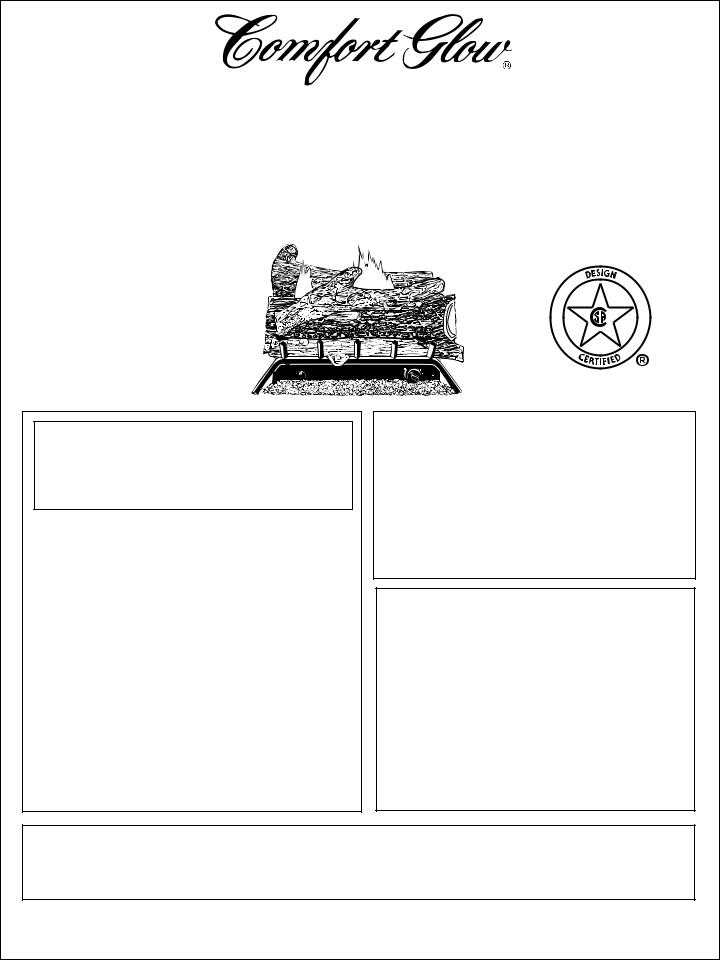
UNVENTED (VENT-FREE)
PROPANE/LP GAS LOG HEATER
(Variable Manually-Controlled Models Also Designed-Certified as
Vented Decorative Appliances)
OWNER’S OPERATION AND INSTALLATION MANUAL
CGG2618P,
CGG3324P(T), and
CGG3630P
Thermostat and
Variably-Controlled Models
WARNING: If the information in this manual is not followed exactly, a fire or explosion may result causing property damage, personal injury, or loss of life.
—Do not store or use gasoline or other flammable vapors and liquids in the vicinity of this or any other appliance.
—WHAT TO DO IF YOU SMELL GAS
•Do not try to light any appliance.
•Do not touch any electrical switch; do not use any phone in your building.
•Immediately call your gas supplier from a neighbor’s phone. Follow the gas supplier’s instructions.
•If you cannot reach your gas supplier, call the fire department.
—Installation and service must be performed by a qualified installer, service agency, or the gas supplier.
WARNING: Improper installation, adjustment, alteration, service, or maintenance can cause injury or property damage. Refer to this manual for correct installation and operational procedures. For assistance or additional information consult a qualified installer, service agency, or the gas supplier.
WARNING: This appliance is for installation only in a solid-fuel burning masonry or UL127 factory-built fireplace, or in an approved ventless firebox. It is design-certified for these installations in accordance with ANS Z21.11.2. Exception: Do not install this appliance in a factory-built fireplace that includes instructions stating it has not been tested or should not be used with unvented gas logs.
WARNING: This is an unvented gas-fired heater. It uses air (oxygen) from the room in which it is installed. Provisions for adequate combustion and ventilation air must be provided. Refer to Air for Combustion and Ventilation section on page 4 of this manual.
This appliance may be installed in an aftermarket* manufactured (mobile) home, where not prohibited by state or local codes.
* Aftermarket: Completion of sale, not for purpose of resale, from the manufacturer
Save this manual for future reference.
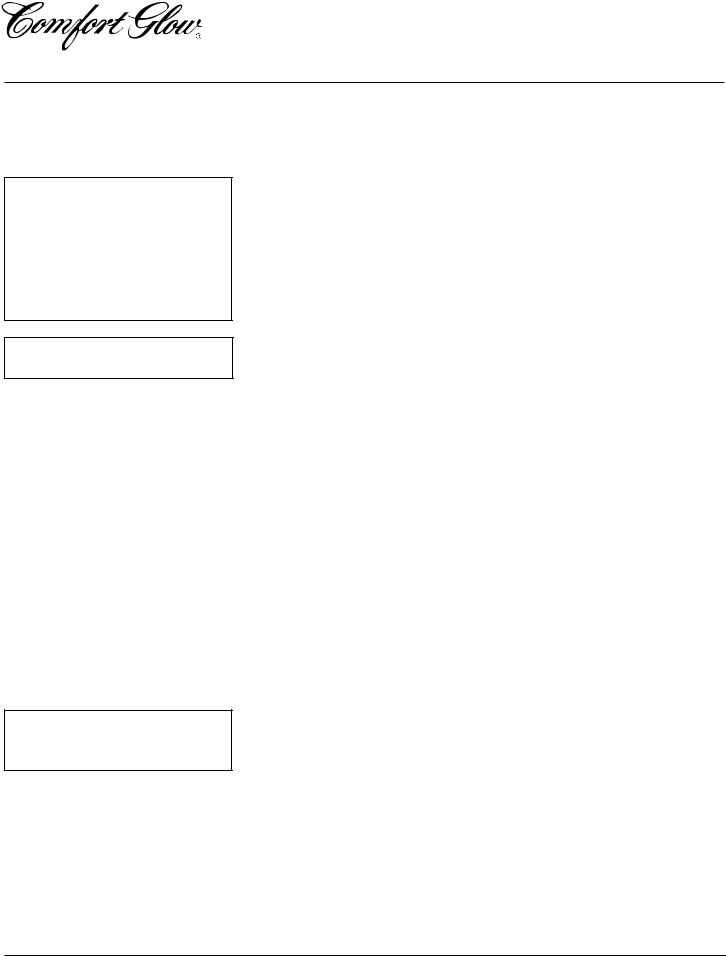
UNVENTED (VENT-FREE) GAS LOG HEATER
SAFETY
INFORMATION
 WARNINGS
WARNINGS
IMPORTANT: Read this owner’s manual carefully and completely before trying to assemble, operate, or service this heater. Improper use of this heater can cause serious injury or death from burns, fire, explosion, electrical shock, and carbon monoxide poisoning.
 DANGER: Carbon monoxide poisoning may lead to death!
DANGER: Carbon monoxide poisoning may lead to death!
Carbon Monoxide Poisoning: Early signs of carbon monoxide poisoning resemble the flu, with headaches, dizziness, or nausea. If you have these signs, the heater may not be working properly. Get fresh air at once! Have heater serviced. Some people are more affected by carbon monoxide than others. These include pregnant women, people with heart or lung disease or anemia, those under the influence of alcohol, and those at high altitudes.
Propane/LP Gas: Propane/LP gas is odorless. An odor-making agent is added to the gas. The odor helps you detect a gas leak. However, the odor added to the gas can fade. Gas may be present even though no odor exists.
Make certain you read and understand all Warnings. Keep this manual for reference. It is your guide to safe and proper operation of this heater.
 WARNING: Any change to this heater or its controls can be dangerous.
WARNING: Any change to this heater or its controls can be dangerous.
1.This appliance is only for use with the type of gas indicated on the rating plate. This appliance is not convertible for use with other gases.
2.Do not place propane/LP supply tank(s) inside any structure. Locate propane/ LP supply tank(s) outdoors.
3.If you smell gas
•shut off gas supply
•do not try to light any appliance
•do not touch any electrical switch; do not use any phone in your building
•immediately call your gas supplier from a neighbor’s phone. Follow the gas supplier’s instructions
•if you cannot reach your gas supplier, call the fire department
4.This heater shall not be installed in a bedroom or bathroom unless installed as a vented appliance (see Installing Damper Clamp, page 10).
5.Never install the heater
•in a recreational vehicle
•where curtains, furniture, clothing, or other flammable objects are less than 42 inches from the front, top, or sides of the heater
•in high traffic areas
•in windy or drafty areas
6.Before installing in a solid fuel burning fireplace, the chimney flue and firebox must be cleaned of soot, creosote, ashes and loose paint by a qualified chimney cleaner. Creosote will ignite if highly heated. Inspect chimney flue for damage. If damaged, operate heater with flue damper closed.
7.If fireplace has glass doors, never operate this heater with glass doors closed. If you operate heater with doors closed, heat buildup inside fireplace will cause glass to burst. Also if fireplace opening has vents at the bottom, you must open the vents before operating heater.
8.You must operate this heater with a fireplace screen in place. Make sure fireplace screen is closed before running heater.
9.This log heater is designed to be smokeless. If logs ever appear to smoke, turn off heater and call a qualified service person. Note: During initial operation, slight smoking could occur due to log curing and heater burning manufacturing residues.
10.To prevent the creation of soot, follow the instructions in Cleaning and Maintenance, page 18.
11.Do not allow fans to blow directly into the fireplace. Avoid any drafts that alter burner flame patterns. Ceiling fans can create drafts that alter burner flame patterns. Altered burner patterns can cause sooting.
12.Before using furniture polish, wax, carpet cleaner, or similar products, turn heater off. If heated, the vapors from these products may create a white powder residue within burner box or on adjacent walls or furniture.
13.Do not use a blower insert, heat exchanger insert or other accessory not approved for use with this heater.
14.This heater needs fresh, outside air ventilation to run properly. This heater has an oxygen depletion sensor (ODS) pilot light safety system. The ODS shuts down the heater if not enough fresh air is available. See Air for Combustion and Ventilation, pages 4 through 6. If heater keeps shutting off, see Troubleshooting, pages 19 through 21.
15.Do not run heater
•where flammable liquids or vapors are used or stored
•under dusty conditions
16.Do not use this heater to cook food or burn paper or other objects.
17.Never place any objects on the heater.
18.Heater base assembly becomes very hot when running heater. Keep children and adults away from hot surface to avoid burns or clothing ignition. Heater will remain hot for a time after shutdown. Allow surface to cool before touching.
19.Carefully supervise young children when they are in the room with heater.
20.Do not use heater if any part has been exposed to or under water. Immediately call a qualified service technician to inspect the room heater and to replace any part of the control system and any gas control which has been under water.
21.Do not operate heater if any log is broken. Do not operate heater if a log is chipped (dime-sized or larger).
22.Turn heater off and let cool before servicing. Only a qualified service person should service and repair heater.
23.Operating heater above elevations of 4,500 feet could cause pilot outage.
24.To prevent performance problems, do not use propane/LP tank of less than 100 lbs. capacity.
2 |
103425 |
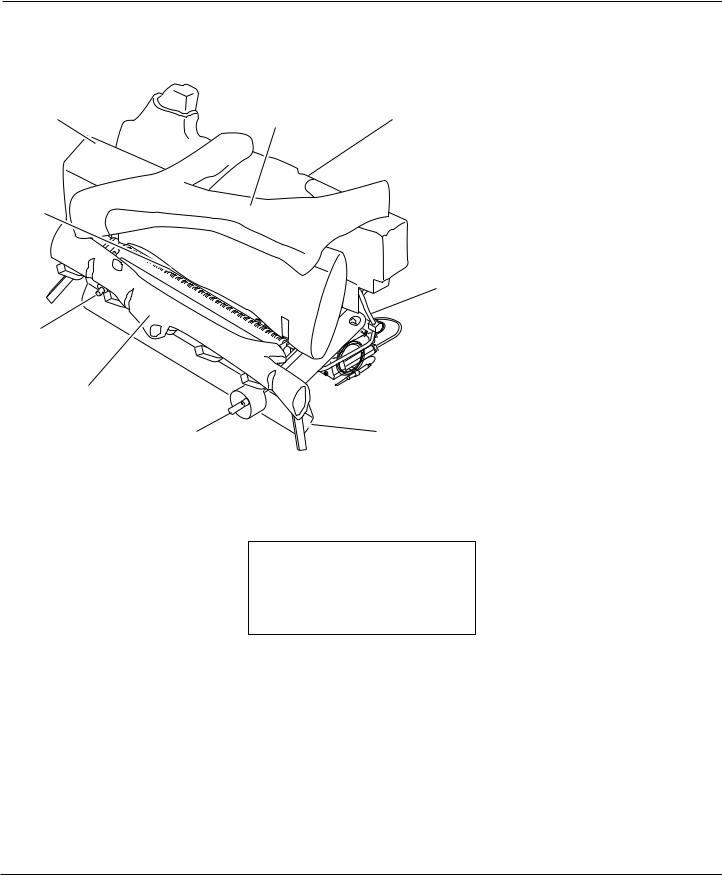
OWNER’S MANUAL
PRODUCT
IDENTIFICATION
Bottom Mid |
|
|
Log (#2) |
Top Log (#4) |
Rear Log (#1) |
Front
Burner
Rear
Burner
Piezo
Ignitor
Front Log (#3)
Control Knob |
Base Assembly |
|
Figure 1 - Vent-Free Gas Log Heater
LOCAL CODES
Install and use heater with care. Follow all local codes. In the absence of local codes, use the latest edition of The National Fuel Gas Code ANS Z223, also known as NFPA 54*.
*Available from:
American National Standards Institute, Inc.
1430 Broadway
New York, NY 10018
National Fire Protection Association, Inc.
Batterymarch Park
Quincy, MA 02269
Note: Where listed vented decorative logs are required, thermostat operation is not permitted.
UNPACKING
 CAUTION: Do not remove the metal data plates attached to the heater base assembly. The data plates contain important warranty information.
CAUTION: Do not remove the metal data plates attached to the heater base assembly. The data plates contain important warranty information.
1.Remove logs and heater base assembly from carton. Note: Do not pick up heater base assembly by burners. This could damage heater. Always handle base assembly by grate.
2.Remove all protective packaging applied to logs and heater for shipment.
3.Check all items for any shipping damage. If damaged, promptly inform dealer where you bought heater.
PRODUCT
FEATURES
OPERATION
This heater is clean burning. It requires no outside venting. There is no heat loss out a vent or up a chimney. Heat is generated by both realistic flames and glowing coals. This heater is designed for vent-free operation. It has been tested and approved to ANS Z21.11.2 standard for unvented heaters. State and local codes in some areas prohibit the use of vent-free heaters. This heater may also be operated as a vented decorative (ANS Z21.60) product by opening the flue damper (non-thermostat operation only).
SAFETY PILOT
This heater has a pilot with an Oxygen Depletion Sensor Shutoff System (ODS). The ODS/pilot is a required feature for ventfree room heaters. The ODS/pilot shuts off the heater if there is not enough fresh air.
PIEZO IGNITION SYSTEM
This heater has a piezo ignitor. This system requires no matches, batteries, or other sources to light heater.
103425 |
3 |

UNVENTED (VENT-FREE) GAS LOG HEATER
AIR FOR COMBUSTION AND VENTILATION
 WARNING: This heater shall notbeinstalledinaconfinedspace or unusually tight construction unless provisions are provided for adequate combustion and ventilation air. Read the following instructions to insure proper fresh air for this and other fuel-burning appliances in your home.
WARNING: This heater shall notbeinstalledinaconfinedspace or unusually tight construction unless provisions are provided for adequate combustion and ventilation air. Read the following instructions to insure proper fresh air for this and other fuel-burning appliances in your home.
Today’s homes are built more energy efficient than ever. New materials, increased insulation, and new construction methods help reduceheatlossinhomes.Homeownersweather strip and caulk around windows and doors to keep the cold air out and the warm air in. During heating months, home owners want their homes as airtight as possible.
While it is good to make your home energy efficient, your home needs to breathe. Fresh air must enter your home. All fuel-burning appliances need fresh air for proper combustion and ventilation.
Exhaust fans, fireplaces, clothes dryers, and fuel burning appliances draw air from the house to operate. You must provide adequate fresh air for these appliances. This will insure proper venting of vented fuelburning appliances.
PROVIDING ADEQUATE VENTILATION
The following are excerpts from National Fuel Gas Code. NFPA 54/ANS Z223.1, Section 5.3, Air for Combustion and Ventilation.
All spaces in homes fall into one of the three following ventilation classifications:
1.Unusually Tight Construction
2.Unconfined Space
3.Confined Space
The information on pages 4 through 6 will help you classify your space and provide adequate ventilation.
Unusually Tight Construction
The air that leaks around doors and windows may provide enough fresh air for combustion and ventilation. However, in buildings of unusually tight construction, you must provide additional fresh air.
Unusually tight construction is defined as construction where:
a.walls and ceilings exposed to the outside atmosphere have a continuous water vapor retarder with a rating of one perm (6 x 10-11 kg per pa-sec-m2) or less with openings gasketed or sealed and
b.weather stripping has been added on openable windows and doors and
c.caulking or sealants are applied to areas such as joints around window and door frames, between sole plates and floors, between wall-ceiling joints, between wall panels, at penetrations for plumbing, electrical, and gas lines, and at other openings.
If your home meets all of the three criteria above, you must provide additional fresh air. See Ventilation Air From Outdoors, page 6.
If your home does not meet all of the three criteria above, proceed to Determining Fresh-Air Flow for Heater Location, page 5.
Confined and Unconfined Space
The National Fuel Gas Code (ANS Z223.1, 1992 Section 5.3) defines a confined space as a space whose volume is less than 50 cubic feet per 1,000 Btu per hour (4.8 m3 per kw) of the aggregate input rating of all appliances installed in that space and an unconfining space as a space whose volume is not less than 50 cubic feet per 1,000 Btu per hour (4.8 m3 per kw) of the aggregate input rating of all appliances installed in that space. Rooms communicating directly with the space in which the appliances are installed*, through openings not furnished with doors, are considered a part of the unconfined space.
This heater shall not be installed in a confined space or unusually tight construction unless provisions are provided for adequate combustion and ventilation air.
* Adjoining rooms are communicating only if there are doorless passageways or ventilation grills between them.
4 |
103425 |

OWNER’S MANUAL
AIR FOR
COMBUSTION AND
VENTILATION
Continued
DETERMINING FRESH-AIR FLOW FOR HEATER LOCATION
Determining if You Have a Confined or Unconfined Space
Use this worksheet to determine if you have a confined or unconfined space.
Space: Includes the room in which you will install heater plus any adjoining rooms with doorless passageways or ventilation grills between the rooms.
1.Determine the volume of the space (length x width x height).
Length x Width x Height = ________________ cu. ft. (volume of space)
Example: Space size 20ft. (length) x 16 ft. (width) x 8 ft. (ceiling height) = 2560 cu. ft. (volume of space)
If additional ventilation to adjoining room is supplied with grills or openings, add the volume of these rooms to the total volume of the space.
2.Divide the space volume by 50 cubic feet to determine the maximum Btu/Hr the space can support.
____________________ (volume of space) ÷ 50 cu. ft. = (Maximum Btu/Hr the space can support)
Example: 2560 cu. ft. (volume of space) ÷ 50 cu. ft. = 51.2 or 51,200 (maximum Btu/Hr the space can support)
3.Add the Btu/Hr of all fuel burning appliances in the space.
Vent-free heater |
___________________ Btu/Hr |
|
|
|
|
Gas water heater* |
___________________ Btu/Hr |
Example: |
|
|
|
Gas furnace |
___________________ Btu/Hr |
Gas water heater |
|
40,000 |
Btu/Hr |
Vented gas heater |
___________________ Btu/Hr |
Vent-free heater |
+ |
33,000 |
Btu/Hr |
Gas fireplace logs |
___________________ Btu/Hr |
|
|
|
|
Total |
= |
73,000 |
Btu/Hr |
||
Other gas appliances* |
+ ___________________ Btu/Hr |
|
|
|
|
Total |
= ___________________ Btu/Hr |
|
|
|
|
*Do not include direct-vent gas appliances. Direct-vent draws combustion air from the outdoors and vents to the outdoors.
4.Compare the maximum Btu/Hr the space can support with the actual amount of Btu/Hr used.
_________________ Btu/Hr (maximum the space can support)
_________________ Btu/Hr (actual amount of Btu/Hr used)
Example: 51,200 Btu/Hr (maximum the space can support)
73,000 Btu/Hr (actual amount of Btu/Hr used)
The space in the above example is a confined space because the actual Btu/Hr used is more than the maximum Btu/Hr the space can support. You must provide additional fresh air. Your options are as follows:
A.Rework worksheet, adding the space of an adjoining room. If the extra space provides an unconfined space, remove door to adjoining room or add ventilation grills between rooms. See Ventilation Air From Inside Building, page 6.
B.Vent room directly to the outdoors. See Ventilation Air From Outdoors, page 6.
C.Install a lower Btu/Hr heater, if lower Btu/Hr size makes room unconfined.
If the actual Btu/Hr used is less than the maximum Btu/Hr the space can support, the space is an unconfined space. You will need no additional fresh air ventilation.
 WARNING: If the area in which the heater may be operated is smaller than that defined as an unconfined space or if the building is of unusually tight construction, provide adequate combustion and ventilati7on air by one of the methods described in the National Fuel Gas Code, ANS Z223.1, 1992, Section 5.3 or applicable local codes.
WARNING: If the area in which the heater may be operated is smaller than that defined as an unconfined space or if the building is of unusually tight construction, provide adequate combustion and ventilati7on air by one of the methods described in the National Fuel Gas Code, ANS Z223.1, 1992, Section 5.3 or applicable local codes.
Continued
103425 |
5 |
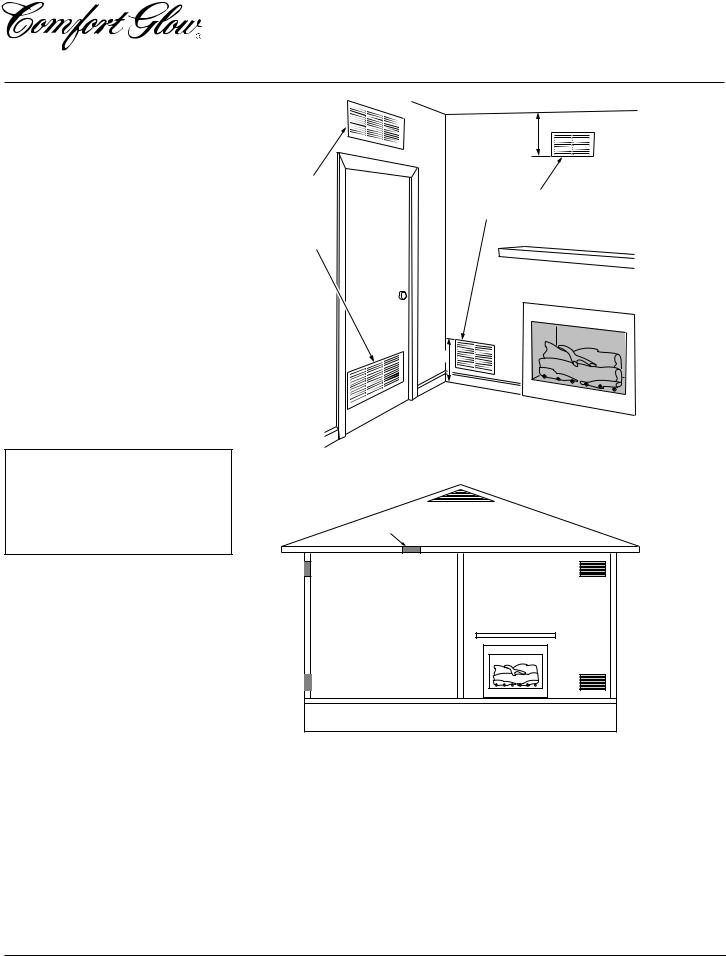
UNVENTED (VENT-FREE) GAS LOG HEATER
AIR FOR COMBUSTION AND VENTILATION
Continued
VENTILATION AIR
Ventilation Air From Inside
Building
This fresh air would come from an adjoining unconfined space. When ventilating to an adjoining unconfined space, you must provide two permanent openings: one within 12" of the ceiling and one within 12" of the floor on the wall connecting the two spaces (see options 1 and 2, Figure 2). You can also remove door into adjoining room (see option 3, Figure 2). Follow the National Fuel Gas Code NFPA 54/ANS Z223.1, Section 5.3, Air for Combustion and Ventilation for required size of ventilation grills or ducts.
 WARNING: Rework worksheet, adding the space of the adjoining unconfined space. The combined spaces must have enough fresh air to supply all appliances in both spaces.
WARNING: Rework worksheet, adding the space of the adjoining unconfined space. The combined spaces must have enough fresh air to supply all appliances in both spaces.
Ventilation Air From Outdoors
Provide extra fresh air by using ventilation grills or ducts. You must provide two permanent openings: one within 12" of the ceiling and one within 12" of the floor. Connect these items directly to the outdoors or spaces open to the outdoors. These spaces include attics and crawl spaces.
IMPORTANT: Do not provide openings for inlet or outlet air into attic if attic has a thermostat-controlled power vent. Heated air entering the attic will activate the power vent.
|
|
12" |
|
Ventilation |
|
Ventilation Grills |
|
Grills |
|
||
Into Adjoining |
Or |
Into Adjoining Room, |
|
Room, |
Option 2 |
||
Remove |
|||
Option 1 |
|
||
Door into |
|
||
|
|
||
|
Adjoining |
|
|
|
Room, |
|
|
|
Option |
|
|
|
3 |
|
|
|
|
12" |
Figure 2 - Ventilation Air from Inside Building
Ventilated
Outlet Attic
Air
Outlet 

Air
To Attic
To
Crawl
Space
Inlet
Air
|
|
Inlet Air |
|
Ventilated |
|
|
|
|
|
|
Crawl Space |
|
|
|
|
|
|
|
|
Figure 3 - Ventilation Air from Outdoors
6 |
103425 |
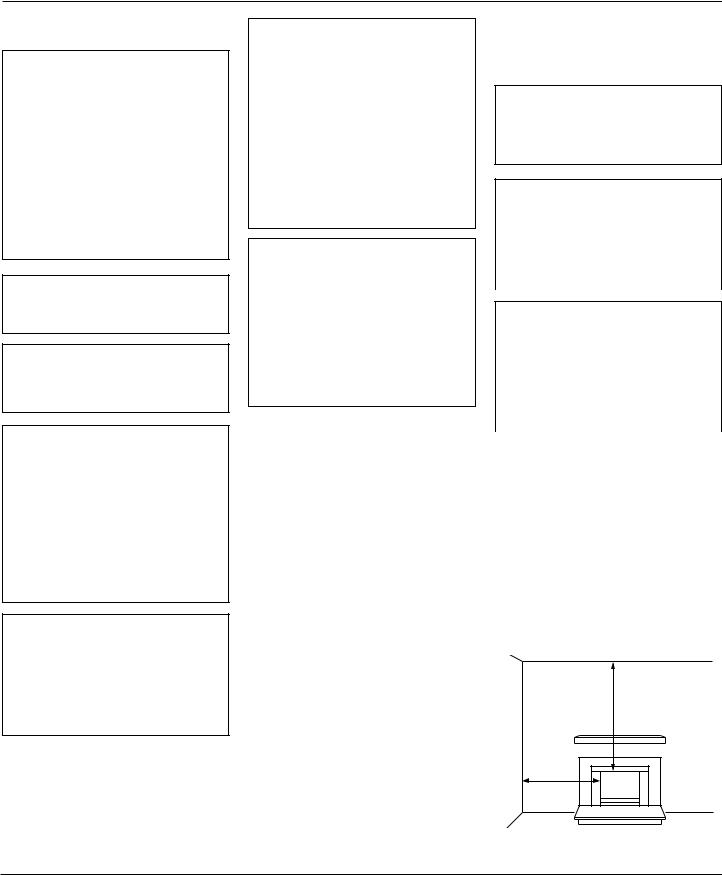
OWNER’S MANUAL
INSTALLATION
NOTICE: This heater is intended for use as supplemental heat. Use this heater along with your primary heating system. Do not install this heater as your primary heat source. If you have a central heating system, you may run system’s circulating blower while using heater. This will help circulate the heat throughout the house. In the event of a power outage, you can use this heater as your primary heat source.
 WARNING: A qualified service person must install heater. Follow all local codes.
WARNING: A qualified service person must install heater. Follow all local codes.
NOTICE: State or local codes may only allow operation of this appliance in a vented configuration. Check your state or local codes.
 WARNING: Before installing in a previously-used wood-burn- ing fireplace, clean chimney flue and firebox. Make sure flue is free of any creosote. Creosote will ignite if highly heated. A dirty chimney flue may create and distribute soot within the house. Inspect chimney flue for damage. If damaged, operate heater with flue damper closed.
WARNING: Before installing in a previously-used wood-burn- ing fireplace, clean chimney flue and firebox. Make sure flue is free of any creosote. Creosote will ignite if highly heated. A dirty chimney flue may create and distribute soot within the house. Inspect chimney flue for damage. If damaged, operate heater with flue damper closed.
 WARNING: Seal any fresh air vents or ash clean-out doors located on floor or wall of fireplace. If not, drafting may cause pilot outage or sooting. Use a heatresistant sealant. Do not seal chimney flue damper.
WARNING: Seal any fresh air vents or ash clean-out doors located on floor or wall of fireplace. If not, drafting may cause pilot outage or sooting. Use a heatresistant sealant. Do not seal chimney flue damper.
 WARNING: Never install the heater
WARNING: Never install the heater
•in a bedroom or bathroom unless installed as a vented appliance, see page 10
•in a recreational vehicle
•where curtains, furniture, clothing, or other flammable objects are less than 42 inches from the front, top, or sides of the heater
•in high traffic areas
•in windy or drafty areas
 CAUTION: This heater creates warm air currents. These currents move heat to wall surfaces next to heater. Installing heater next to vinyl or cloth wall coverings or operating heater where impurities (such as tobacco smoke, aromatic candles, cleaning fluids, oil or kerosene lamps, etc.) in the air exist, may discolor walls.
CAUTION: This heater creates warm air currents. These currents move heat to wall surfaces next to heater. Installing heater next to vinyl or cloth wall coverings or operating heater where impurities (such as tobacco smoke, aromatic candles, cleaning fluids, oil or kerosene lamps, etc.) in the air exist, may discolor walls.
IMPORTANT: Vent-free heaters add moisture to the air. Although this is beneficial, installing heater in rooms without enough ventilation air may cause mildew to form from too much moisture. See Air for Combustion and Ventilation, pages 4 through 6.
CHECK GAS TYPE
Use only propane/LP gas. If your gas supply is not propane/LP, do not install heater. Call dealer where you bought heater for proper type heater.
INSTALLATION AND CLEARANCES
(Vent-Free Operation Only)
 WARNING: Maintain the minimum clearances. If you can, provide greater clearances from floor, ceiling, and adjoining wall.
WARNING: Maintain the minimum clearances. If you can, provide greater clearances from floor, ceiling, and adjoining wall.
MINIMUM FIREPLACE
CLEARANCE TO
COMBUSTIBLE MATERIALS
Log Size |
Side Wall |
Ceiling |
|
|
|
18", 24", 30" |
16" |
42" |
|
|
|
LOG SIZING REQUIREMENTS
Log |
Minimum Firebox |
||
Size |
Height |
Depth |
Front |
|
|
|
Width |
|
|
|
|
18" |
17" |
14" |
20" |
24" |
17" |
14" |
26" |
30" |
17" |
14" |
32" |
|
|
|
|
Carefully follow the instructions below. This will ensure safe installation into a masonry, UL127-listed manufactured fireplace, or listed vent-free firebox.
Minimum Wall and Ceiling
Clearances (see Figure 4)
A.Clearances from the side of the fireplace opening to any combustible wall should not be less than 16 inches.
B.Clearances from the top of the fireplace opening to the ceiling should not be less than 42 inches.
42"
16"
Left and
Right Sides
Figure 4 - Minimum Clearance to Wall and
Ceiling
Continued
103425 |
7 |

UNVENTED (VENT-FREE) GAS LOG HEATER
INSTALLATION
Continued
NOTICE: Manual control heaters may be used as a vented product. If so, you must always run heater with chimney flue damper open. If running heater with damper open, noncombustible material above fireplace opening is not needed. Go to Installing Damper Clamp Accessory for Vented Operation, page 10.
Minimum Noncombustible
Material Clearances
If Not Using Mantel
Note: If using a mantel, proceed to If Using Mantel. If not using a mantel, follow the information on this page.
You must have noncombustible material(s) above the fireplace opening. Noncombustible materials (such as slate, marble, tile, etc.) must be at least 1/2 inch thick. With sheet metal, you must have noncombustible material behind it. Noncombustible material must extend at least 8" up (for all models). If noncombustible material is less than 12", you must install the fireplace hood accessory (24" and 30" models only). See Figure 5 for minimum clearances.
IMPORTANT: If you cannot meet these minimum clearances, you must operate heater with chimney flue damper open. Go to Installing Damper Clamp Accessory for Vented Operation, page 10.
If Using Mantel
You must have noncombustible material(s) above the fireplace opening. Noncombustible materials (such as slate, marble, tile, etc.) must be at least 1/2 inch thick. With sheet metal, you must have noncombustible material behind it. Noncombustible material must extend at least 8 inches up (for all models). If noncombustible material is less than 12", you must install the fireplace hood accessory (24" and 30" models only). Even
if noncombustible material is more than 12", you may need the hood accessory to deflect heat away from your mantel shelf. See Figure 5 and Figures 6 and 7, page 9, for minimum clearances.
IMPORTANT: If you cannot meet these minimum clearances, you must operate heater with chimney flue damper open. Go to Installing Damper Clamp Accessory for Vented Operation, page 10.
Noncombustible |
Requirements for |
Material Distance (A) |
Safe Installation |
|
|
12" or more |
Noncombustible material OK. |
Between 8" and 12" |
24" or 30" Models: Install fireplace hood accessory |
|
(GA6050 or GA6052, see Accessories, page 28). |
|
18" Model: Noncombustible material OK. No hood |
|
accessory needed. |
Less than 8" |
Noncombustible material must be extended to at |
|
least 8". See Between 8" and 12", above. If you |
|
cannot extend material, you must operate heater |
|
with flue damper open. |
|
|
Heat Resistant 
Material
(A)
Figure 5 - Heat Resistant Material (Slate, Marble, Tile, etc.) Above Fireplace
8 |
103425 |
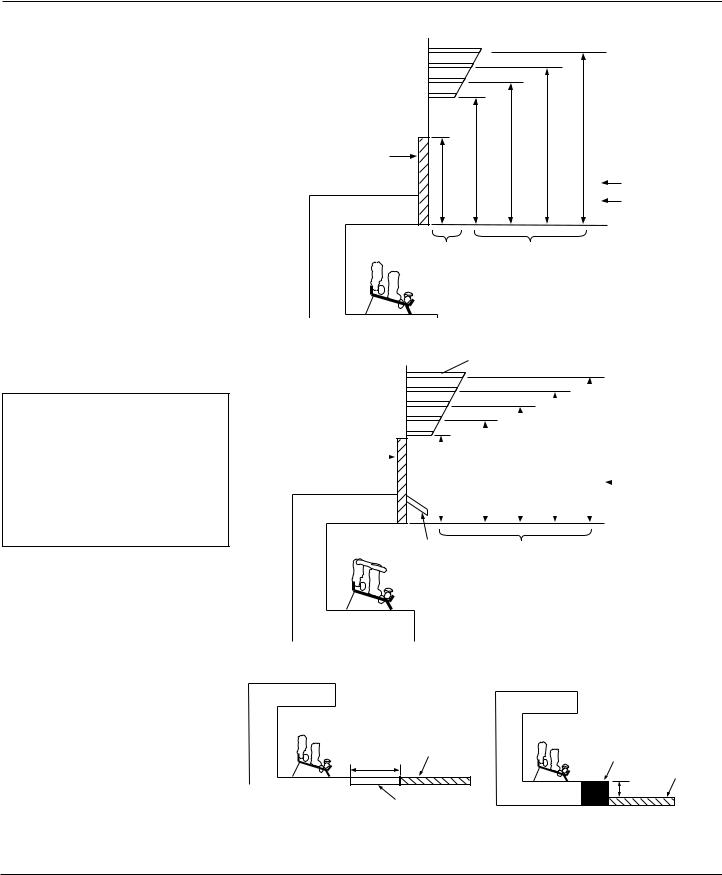
OWNER’S MANUAL
INSTALLATION
Continued
MANTEL CLEARANCES
In addition to meeting noncombustible material clearances, you must also meet required clearances between fireplace opening and mantel shelf. If you do not meet the clearances listed below, you will need a hood.
Determining Minimum Mantel
Clearance
If you meet minimum clearance between mantel shelf and top of fireplace opening, a hood is not required (see Figure 6).
Determining Minimum Mantel
Clearance When Using a Hood
If minimum clearances in Figure 6 are not met, you must have a hood. When using a hood there are still certain minimum mantel clearances required. Follow minimum clearances shown in Figure 7 when using hood.
NOTICE: If your installation does not meet the minimum clearances shown, you must do one of the following:
•operate the logs only with the flue damper open
•raise the mantel to an acceptable height
•remove the mantel
FLOOR CLEARANCES
A.If installing appliance on the floor level, you must maintain the minimum distance of 14" to combustibles (see Figure 8).
B.If combustible materials are less than 14" from the fireplace, you must install appliance at least 5" above the combustible flooring (see Figure 9).
Mantel Shelf
10" 
Underside of
|
8" |
|
|
|
|
Mantel Shelf |
|
|
|
|
|
|
|
||
|
6" |
|
|
|
|
|
|
|
2 1/2" |
|
|
|
|
|
|
|
|
|
|
|
|
All minimum |
|
|
|
|
|
|
|
distances are |
|
|
|
|
|
|
|
in inches |
|
Minimum Non- |
(A) |
|
|
|
|
|
|
Combustible |
|
|
|
|
Log Set |
||
|
|
|
|
|
|||
Material |
|
|
|
|
|
||
12" |
20" |
25" |
28" |
30" |
24"/30" Models |
||
|
|||||||
|
8" |
14" |
17" |
19" |
20" |
18" Model |
|
|
|
|
|
|
|
Top of Fireplace |
|
|
|
|
|
|
|
Opening |
|
|
Minimum Non- |
Distances to |
|
|
|||
|
Combustible |
|
Underside of |
|
|
||
|
Material Height |
Mantel |
|
|
|
||
Figure 6 - Minimum Mantel Clearances Without Using Hood
Mantel Shelf
12"
Underside of
|
10" |
|
|
|
|
|
Mantel Shelf |
||
|
|
|
|
|
|
|
|
||
|
8" |
|
|
|
|
|
|
|
|
|
|
|
|
|
|
|
|
||
|
6" |
|
|
|
|
|
|
|
|
|
|
|
|
|
|
|
|
||
|
2 1/2" |
|
|
|
|
|
All minimum |
||
|
|
|
|
|
|
||||
|
|
|
|
|
|
|
|
||
|
|
|
|
|
|
|
|
distances are |
|
Minimum Non- |
|
|
|
|
|
|
|
in inches |
|
|
|
|
|
|
|
|
|
|
|
Combustible |
|
|
|
|
|
|
|
|
Log Sets |
Material |
|
|
8" |
12" |
15" |
18" |
20" |
|
18", 24", |
|
|
|
|||||||
|
|
|
Min. |
|
|
|
|
|
& 30" Models |
|
|
|
|
|
|
|
|
|
|
Top of Fireplace
Opening
Hood |
Distances to |
|
(GA6050, GA6052) |
||
Underside of |
||
|
||
|
Mantel |
Figure 7 - Minimum Mantel Clearances When Using Hood
|
Combustible |
|
14" |
Material |
Hearth |
|
||
Min. |
|
Combustible |
|
|
Material |
|
|
5" |
|
Noncombustible |
Min. |
|
|
|
|
Material |
|
Figure 8 - Minimum Fireplace Clearances |
Figure 9 - Minimum Fireplace Clearances |
|
If Installed at Floor Level |
|
Above Combustible Flooring |
Continued
103425 |
9 |
